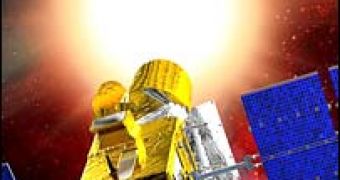A new spacecraft for hunting Earth like planets is going to be launched by French space agency CNES.
The 650 kg spacecraft, named Corot, could detect rocky planets just a few times bigger than Earth, around neighboring stars. Corot will also study the stars themselves: their mass, age and chemical composition. "Man has been thinking about other worlds since the beginning of astronomy. Corot will help us to understand whether Earth-like exoplanets are a reality or dream." said Thien Lam Trong, Corot Project Manager from CNES.
Corot will be launched from the Baikonur Cosmodrome, Kazakhstan, into a polar orbit 827km (514 miles) above the Earth. Corot uses a 27cm (11in) telescope and a four-charge-coupled-device (CCD) camera, sensitive to tiny changes in the brightness of stars. "There are two main science objectives for this mission," said Ian Roxburgh, professor of astronomy at Queen Mary, University of London, who is the European Space Agency (ESA) scientist on Corot.
ESA is a partner on Corot along with Austria, Spain, Germany, Belgium and Brazil. "And one of these, he said, would be to monitor about 60,000 stars to find some of the planets orbiting them."
"As a planet comes in-between us, the observer, and the star, it goes across the front of the star and blocks out some of the light - this is called a transit, like the transit of Venus."
"So we will be measuring the light from the stars, looking for decreases in brightness to detect if a planet is in orbit."
Corot will investigate on five to six different areas of the sky over 2.5 years, each time for a duration of about 150 days. Every 512 seconds, it will capture the brightness of approximately 10,000 stars with by the onboard camera, allowing minute changes in the light intensity to be detected. The contrasts will uncover different types of planets, from huge gaseous ones to small rocky planets. The smaller planets are the main target of Corot. "While larger planets can be detected from the ground using a variety of techniques, explained Roxburgh, planets nearing Earth's size cannot."
"Corot will be the first spacecraft capable of finding them," he said. "We should be able to get down to planets about twice as big as Earth."
Most probably 10-40 smaller planets and tens of larger gaseous ones in each of the star fields will be observed.
By astroseismology - which uses the subtle changes in light created as sound waves ripple through the star - more data about stars themselves will be gathered, like its mass, age and chemical composition. 60 of the brightest stars in the area of the sky will be targeted. "This, he said, would add to data currently being collected by another Canadian mission, called MOST, which is using a 15cm (6in) telescope aboard a satellite to study the sky."
"Corot will cover a large selection of stars - this is important because you need a good sample of different sorts of stars, with different properties and different ages, in order to understand stellar evolution."
After 2010, ESA plans to launch the Darwin flotilla, of four or five spacecrafts, that will hunt for Earth-like planets around other stars and analyze their atmospheres for signs of extra-terrestrial life. NASA is to launch a Terrestrial Planet Finder (TPF) which will also aim to uncover Earth-like worlds. "Corot is a pioneer as far as planets are concerned." said Roxburgh. "It will enable us to get knowledge of the sorts of stars that have planets and that sort of information will be needed for the next generation of missions searching for signs of habitable planets."
Image credit: CNES

 14 DAY TRIAL //
14 DAY TRIAL //